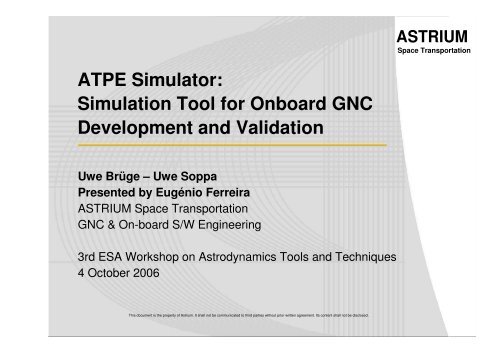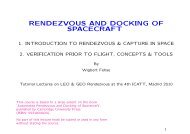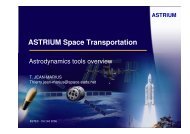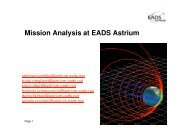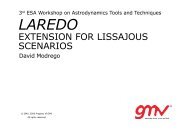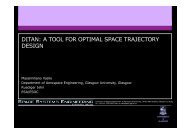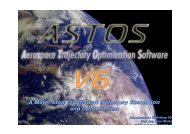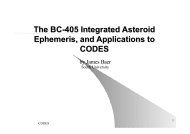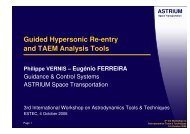ATPE Simulator: Simulation Tool for Onboard GNC ... - ESA
ATPE Simulator: Simulation Tool for Onboard GNC ... - ESA
ATPE Simulator: Simulation Tool for Onboard GNC ... - ESA
Create successful ePaper yourself
Turn your PDF publications into a flip-book with our unique Google optimized e-Paper software.
ASTRIUM<br />
Space Transportation<br />
<strong>ATPE</strong> <strong>Simulator</strong>:<br />
<strong>Simulation</strong> <strong>Tool</strong> <strong>for</strong> <strong>Onboard</strong> <strong>GNC</strong><br />
Development and Validation<br />
Uwe Brüge – Uwe Soppa<br />
Presented by Eugénio Ferreira<br />
ASTRIUM Space Transportation<br />
<strong>GNC</strong> & On-board S/W Engineering<br />
3rd <strong>ESA</strong> Workshop on Astrodynamics <strong>Tool</strong>s and Techniques<br />
4 October 2006<br />
This document is the property of Astrium. It shall not be communicated to third parties without prior written agreement. Its content shall not be disclosed.
Contents<br />
ASTRIUM<br />
Space Transportation<br />
• Overall <strong>Simulator</strong> Concept<br />
• <strong>ATPE</strong> <strong>Simulator</strong> Approach<br />
• <strong>ATPE</strong> Introduction and Requirements<br />
• Simulated Missions<br />
• <strong>Simulator</strong> Structure<br />
• Transfer to Realtime Environment<br />
• Extensions <strong>for</strong> additional Systems<br />
• Summary & Outlook<br />
Page 1<br />
3 rd Intl Workshop on<br />
Astrodynamics <strong>Tool</strong>s & Techniques<br />
2-5 October 2006
Overall <strong>Simulator</strong> Concept<br />
ASTRIUM<br />
Space Transportation<br />
System Spec. Phase<br />
Trajectory analysis<br />
Mission design<br />
(3-DOF)<br />
Flight Mechanics<br />
(FM) (6-DOF)<br />
<strong>GNC</strong> Design<br />
(6-DOF)<br />
<strong>Simulator</strong> A<br />
<strong>Simulator</strong> B<br />
<strong>Simulator</strong> C<br />
Measures to<br />
enhance Efficiency<br />
Definition of a Unified<br />
<strong>Simulator</strong> Family<br />
• Reuse of components as<br />
single-source models<br />
• Integrated design approach<br />
• Use COTS SW <strong>for</strong><br />
<strong>GNC</strong> development &<br />
SW engineering process<br />
Detailed<br />
Design, AIT<br />
Page 2<br />
<strong>GNC</strong> Detailed Design<br />
(6-DOF)<br />
<strong>GNC</strong> Flight S/W<br />
(Real-Time)<br />
<strong>Simulator</strong> D<br />
<strong>Simulator</strong> E<br />
• Reduce costs<br />
• Reduce turn around cycle<br />
after problem identification<br />
• Simplify IF to external<br />
partners<br />
3 rd Intl Workshop on<br />
Astrodynamics <strong>Tool</strong>s & Techniques<br />
2-5 October 2006
<strong>ATPE</strong> <strong>Simulator</strong> Approach<br />
ASTRIUM<br />
Space Transportation<br />
1. Design and preliminary evaluation of <strong>GNC</strong> onboard software<br />
within engineering environment<br />
(minimize extra ef<strong>for</strong>t <strong>for</strong> SW development as much as possible)<br />
2. Rapid software migration to real time environment via<br />
autocoding<br />
3. <strong>GNC</strong> on-board software validation in real time<br />
<strong>ATPE</strong><br />
<strong>Simulator</strong><br />
• <strong>Tool</strong>s:<br />
– Development simulator<br />
Development<br />
Environment<br />
Real Time<br />
Environment<br />
– Autocoding tools<br />
– Real time simulator<br />
<strong>GNC</strong> algorithm<br />
development<br />
and<br />
evaluation<br />
Autocode<br />
<strong>GNC</strong> algorithm<br />
Real Time<br />
Validation<br />
Page 3<br />
3 rd Intl Workshop on<br />
Astrodynamics <strong>Tool</strong>s & Techniques<br />
2-5 October 2006
<strong>ATPE</strong> <strong>Simulator</strong> Introduction<br />
ASTRIUM<br />
Space Transportation<br />
• Developed within <strong>ATPE</strong> (Aeroassist Technologies <strong>for</strong> Planetary<br />
Exploration) project, under contract to <strong>ESA</strong><br />
– Technology development study, targeting the design, development<br />
and test of <strong>GNC</strong> <strong>for</strong> aeroassist technologies <strong>for</strong> planetary exploration<br />
• Extended to other mission phases after <strong>ATPE</strong> project, e.g.:<br />
– Pre and post aerocapture phases (<strong>ATPE</strong> CCN)<br />
– Mars Ascent in the frame of the Planetary Ascent Vehicle Contract<br />
(models implemented by SciSys (UK))<br />
– RLV end-to-end simulation (internal studies and ASTRA)<br />
– Small capsule entry (PARES)<br />
Page 4<br />
3 rd Intl Workshop on<br />
Astrodynamics <strong>Tool</strong>s & Techniques<br />
2-5 October 2006
<strong>Simulator</strong> User Requirements<br />
ASTRIUM<br />
Space Transportation<br />
• The simulator shall be modular, easy-to-use, and expandable<br />
• The simulator shall support the design and evaluation of <strong>GNC</strong> algorithms<br />
• The simulator shall include<br />
– 3 and 6 DOF dynamics, environment models, vehicle models including<br />
aerodynamics and propulsion, sensor models, and actuators models<br />
• <strong>Simulator</strong> architecture and coding standards shall support the migration<br />
to real-time environment<br />
• The following functionalities shall be included<br />
– Monte-Carlo<br />
– Graphical User Interface (GUI)<br />
– Interface to <strong>ESA</strong>’s trajectory optimization tool ASTOS<br />
– Interface to visualization tool STK<br />
• <strong>Simulator</strong> was implemented in Matlab/Simulink<br />
Page 5<br />
3 rd Intl Workshop on<br />
Astrodynamics <strong>Tool</strong>s & Techniques<br />
2-5 October 2006
Mission Phases Simulated during <strong>ATPE</strong><br />
ASTRIUM<br />
Space Transportation<br />
Aero<br />
Capture<br />
(AC)<br />
Aero<br />
Braking<br />
(AB)<br />
Aero<br />
Gravity<br />
Assist<br />
(AGA)<br />
Entry<br />
Parafoil<br />
MSR (Mars Sample Return)<br />
2<br />
2<br />
1<br />
VSR (Venus Sample Return)<br />
2<br />
1<br />
2<br />
1<br />
ESR (Europa Sample Return)<br />
1<br />
1<br />
2<br />
1<br />
MM (Manned Mars)<br />
1<br />
2<br />
1<br />
EDM (Earth Demo Mission)<br />
1<br />
Total<br />
7<br />
1<br />
1<br />
8<br />
4<br />
Page 6<br />
3 rd Intl Workshop on<br />
Astrodynamics <strong>Tool</strong>s & Techniques<br />
2-5 October 2006
Mission Phases Simulated up to now<br />
(extention to <strong>ATPE</strong> project)<br />
ASTRIUM<br />
Space Transportation<br />
Ascent<br />
AC<br />
Pre<br />
AC<br />
Post<br />
AC<br />
AB<br />
AGA<br />
Entry<br />
Coast<br />
TAEM<br />
Parafoil<br />
MSR<br />
1<br />
2<br />
2<br />
2<br />
2<br />
1<br />
VSR<br />
2<br />
1<br />
2<br />
1<br />
ESR<br />
1<br />
1<br />
2<br />
1<br />
MM<br />
1<br />
1<br />
2<br />
1<br />
EDM<br />
1<br />
RLV<br />
1<br />
1<br />
1<br />
1<br />
PARES<br />
1<br />
Total<br />
3<br />
7<br />
2<br />
2<br />
1<br />
1<br />
10<br />
1<br />
1<br />
4<br />
Page 7<br />
3 rd Intl Workshop on<br />
Astrodynamics <strong>Tool</strong>s & Techniques<br />
2-5 October 2006
<strong>Simulator</strong> Structure<br />
ASTRIUM<br />
Space Transportation<br />
1<br />
User Interface:<br />
Interface<br />
2<br />
Mission<br />
Definition:<br />
Mission A Mission B Mission C<br />
Mission Phases: Phase 1 Phase 2 Phase 3 Phase 4 Phase 5<br />
Kernel Models:<br />
Initial<br />
Workspace<br />
Simulink Kernel<br />
Model <strong>for</strong> Phase 3<br />
<strong>Simulation</strong><br />
Results<br />
3<br />
6 DoF Dyn<br />
Navigation<br />
Model Library:<br />
Aerodyn<br />
Guidance<br />
Page 8<br />
Environment<br />
<strong>Simulator</strong><br />
Control<br />
<strong>Onboard</strong> S/W<br />
3 rd Intl Workshop on<br />
Astrodynamics <strong>Tool</strong>s & Techniques<br />
2-5 October 2006
<strong>Simulator</strong> Structure (cont)<br />
ASTRIUM<br />
Space Transportation<br />
1<br />
2<br />
User Interface:<br />
Graphical User Interface<br />
Mission Definition: Mission A Mission B Mission C<br />
Mission Phases: Phase 1 Phase 2 Phase 3 Phase 4 Phase 5<br />
Simulink Kernel Model<br />
Kernel Models:<br />
Initial<br />
Workspace<br />
Simulink Kernel<br />
Model <strong>for</strong> Phase 3<br />
<strong>Simulation</strong><br />
Results<br />
3<br />
6 DoF Dyn<br />
Navigation<br />
Model Library:<br />
Aerodyn<br />
Guidance<br />
Environment<br />
<strong>Simulator</strong><br />
Control<br />
<strong>Onboard</strong> S/W<br />
Page 9<br />
3 rd Intl Workshop on<br />
Astrodynamics <strong>Tool</strong>s & Techniques<br />
2-5 October 2006
<strong>Simulator</strong> Structure (cont)<br />
ASTRIUM<br />
Space Transportation<br />
1<br />
2<br />
User Interface:<br />
Mission Definition:<br />
Graphical User Interface<br />
Mission A Mission B Mission C<br />
Simulink Function Module<br />
Mission Phases: Phase 1 Phase 2 Phase 3 Phase 4 Phase 5<br />
Kernel Models:<br />
Initial<br />
Workspace<br />
Simulink Kernel<br />
Model <strong>for</strong> Phase 3<br />
<strong>Simulation</strong><br />
Results<br />
3<br />
6 DoF Dyn<br />
Navigation<br />
Model Library:<br />
Aerodyn<br />
Guidance<br />
Environment<br />
<strong>Simulator</strong><br />
Control<br />
<strong>Onboard</strong> S/W<br />
Simulink Function Module<br />
INPUT<br />
PARAMETER<br />
OUTPUT<br />
Controlled by Function ICD<br />
· Input<br />
· Output<br />
· Parameter<br />
Page 10<br />
3 rd Intl Workshop on<br />
Astrodynamics <strong>Tool</strong>s & Techniques<br />
2-5 October 2006
Libraries<br />
ASTRIUM<br />
Space Transportation<br />
• <strong>Onboard</strong> Library<br />
– Guidance, Navigation & Control <strong>for</strong>:<br />
aerocapture, aerobraking, aerogravity assist, entry, Mars ascent, TAEM, and parafoil<br />
• Model Library<br />
– Actuator models: Attitude control thrusters, trajectory control thrusters,<br />
aerodynamic surfaces, winch models<br />
– Aerodynamic models: Inflatable spacecraft, Apollo-like spacecraft, waverider,<br />
Mars Launcher, Hopper, PARES<br />
– Dynamic models: 6-dof, 3-dof, 4-dof (Parafoil)<br />
– Propulsion models: Hopper, Mars Launcher<br />
– Environment models: Earth, Mars, Sun, Venus, Jupiter<br />
– Sensor models: INS, radar altimeter, GPS, Star-tracker, DSN<br />
– Trans<strong>for</strong>mations: Approx. 50 frame trans<strong>for</strong>mations<br />
Page 11<br />
3 rd Intl Workshop on<br />
Astrodynamics <strong>Tool</strong>s & Techniques<br />
2-5 October 2006
Other Functionalities<br />
ASTRIUM<br />
Space Transportation<br />
• Graphical User Interface<br />
– run, modify, and analyze results of all mission phases.<br />
• Monte Carlo capability<br />
– Main uncertainties considered:<br />
· mass, CoG location, aerodynamic coefficients, propulsion<br />
characteristics, RCS and TCM thrust, sensor characteristics,<br />
atmospheric and environment characteristics, initial conditions<br />
• STK and ASTOS interfaces<br />
– <strong>ATPE</strong> simulator receives input data from ASTOS, and automatically<br />
updates the required initialization files.<br />
– STK interface is included <strong>for</strong> detailed visualization<br />
Page 12<br />
3 rd Intl Workshop on<br />
Astrodynamics <strong>Tool</strong>s & Techniques<br />
2-5 October 2006
Migration to Realtime Environment<br />
ASTRIUM<br />
Space Transportation<br />
Migration to a representative<br />
real-time environment in a two<br />
board implementation<br />
Single board PPC VME based rack<br />
Tornado host<br />
Environment<br />
(Win2000)<br />
Motorola MVME 5100<br />
with<br />
450 MHz Power PC CPU<br />
Page 13<br />
Ethernet Local network<br />
3 rd Intl Workshop on<br />
Astrodynamics <strong>Tool</strong>s & Techniques<br />
2-5 October 2006
RT Migration Process<br />
Two Chassis Implementation<br />
Software transfer from Simulink to RT ANSI-<br />
C tasks directly from s-function interface<br />
or via autocoding<br />
<strong>Onboard</strong> CPU<br />
ASTRIUM<br />
Space Transportation<br />
Simulink Kernel Model<br />
Software transfer from Simulink to WS via<br />
autocoding<br />
Page 14<br />
Workstation<br />
Network connection by means<br />
of a socket interface provided<br />
by EADS ST Libraries<br />
3 rd Intl Workshop on<br />
Astrodynamics <strong>Tool</strong>s & Techniques<br />
2-5 October 2006
Unified <strong>Simulator</strong> Concept So Far Achieved<br />
ASTRIUM<br />
Space Transportation<br />
<strong>Simulator</strong> Family Approach initiated, First Applications<br />
- X-38, Phoenix, <strong>ATPE</strong><br />
Usage of Commercial <strong>GNC</strong> Development <strong>Tool</strong>s<br />
- Matlab/Simulink<br />
Reuse of components<br />
- Based on Simulink library<br />
- Autocoding of Simulink modules via Matlab‘s Realtime Workshop<br />
Usage of Commercial S/W Engineering <strong>Tool</strong>s<br />
- Only in part: S/W configuration management with Per<strong>for</strong>ce<br />
- Planned next step: Coupling of S/W engineering methods and tools<br />
with <strong>GNC</strong> development process, e.g. application of UML and tools<br />
like Artisan or Rational Rose<br />
Page 15<br />
3 rd Intl Workshop on<br />
Astrodynamics <strong>Tool</strong>s & Techniques<br />
2-5 October 2006
<strong>ATPE</strong> <strong>Simulator</strong> Extensions <strong>for</strong><br />
Mars Mission Analysis (1)<br />
ASTRIUM<br />
Space Transportation<br />
• <strong>ATPE</strong> simulator upgrade Apr-Jul 2005<br />
– Decelerator system model<br />
· Multiple stage round parachutes (user defined)<br />
· Modeling of filling process<br />
· 6-DoF dynamics of descent<br />
configuration with variable mass<br />
· Fixed thrust retro-rocket system<br />
– Interfacing with existing<br />
<strong>ATPE</strong> Mars entry scenarios<br />
– Monte Carlo simulation capability<br />
· Density and 3D wind model<br />
· Decelerator system parameters<br />
Page 16<br />
· Entry phase dispersion<br />
3 rd Intl Workshop on<br />
Astrodynamics <strong>Tool</strong>s & Techniques<br />
2-5 October 2006
<strong>ATPE</strong> <strong>Simulator</strong> Extensions <strong>for</strong><br />
Mars Mission Analysis (2)<br />
ASTRIUM<br />
Space Transportation<br />
• <strong>ATPE</strong> simulator upgrade Aug-Dec 2005<br />
– Powered landing (Viking type)<br />
· Spin off from lunar landing initiative<br />
· 6 DoF rigid body dynamics with variable mass<br />
· Pulse modulated thruster management function<br />
· Slew angle controlled horizontal displacement<br />
· Navigation represented by parametric transfer functions<br />
– Interfacing with existing<br />
<strong>ATPE</strong> Mars entry scenarios<br />
– Monte Carlo simulation capability<br />
· Density and 3D wind model<br />
· Decelerator system parameters<br />
Page 17<br />
· RCS per<strong>for</strong>mance parameters<br />
3 rd Intl Workshop on<br />
Astrodynamics <strong>Tool</strong>s & Techniques<br />
2-5 October 2006
<strong>ATPE</strong> <strong>Simulator</strong> Extensions <strong>for</strong><br />
Mars Mission Analysis (3)<br />
ASTRIUM<br />
Space Transportation<br />
• <strong>ATPE</strong> simulator upgrade Jan-Apr 2006<br />
– Retro Rocket Firing Control Algorithm<br />
· Fixed thrust retro-rocket system<br />
(single or dual stage)<br />
· Fixed thrust lateral rocket system ("TIRS")<br />
· Closed loop firing logic implementation <strong>for</strong><br />
mitigation of descent speed, wind,<br />
density, thrust variation<br />
– Interfacing with existing<br />
<strong>ATPE</strong> Mars entry scenarios<br />
– Monte Carlo simulation capability<br />
· Density and 3D wind model<br />
· Decelerator system parameters<br />
Page 18<br />
· RCS per<strong>for</strong>mance parameters<br />
3 rd Intl Workshop on<br />
Astrodynamics <strong>Tool</strong>s & Techniques<br />
2-5 October 2006
<strong>ATPE</strong> <strong>Simulator</strong> Extensions <strong>for</strong><br />
Mars Mission Analysis (4)<br />
ASTRIUM<br />
Space Transportation<br />
• <strong>ATPE</strong> simulator upgrade May-Jul 2006<br />
Page 19<br />
– Multi-Body parachute descent dynamics model<br />
· Using Matlab SimMechanis toolbox<br />
· Equivalent rigid body models of<br />
parachute canopy, backshell, lander<br />
· Parachute apparent mass effects<br />
· Elastic bridles and lines with damping<br />
· Suspension tripods as nonlinear joints<br />
· Retro rocket and TIRS rocket systems<br />
– Standalone tool using <strong>ATPE</strong> coding standards & libraries<br />
– Used <strong>for</strong> analysis of retro rocket phase dynamics and<br />
firing logic per<strong>for</strong>mance analyses<br />
– Fast engineering tool version <strong>for</strong> MC analysis, needs parameters from<br />
high fidelity FE models to be accurate<br />
3 rd Intl Workshop on<br />
Astrodynamics <strong>Tool</strong>s & Techniques<br />
2-5 October 2006
Summary<br />
ASTRIUM<br />
Space Transportation<br />
• Aeroassist Maneuver <strong>Simulation</strong> <strong>Tool</strong>:<br />
– Modular, expandable and flexible<br />
– Covering all envisaged mission phases<br />
– Includes GUI, Monte-Carlo capability, and ASTOS & STK interfaces<br />
– Design supports the transfer to a representative real-time environment<br />
• First applications:<br />
– X-38, Phoenix, <strong>ATPE</strong><br />
– Extension <strong>for</strong> Mission analysis <strong>for</strong> Mars descent scenarios (e.g.<br />
Exomars)<br />
• Next steps:<br />
Page 20<br />
– Extension <strong>for</strong>: RLV’s (Hopper end-to-end simulation tool) and<br />
Small entry capsules (PARES)<br />
3 rd Intl Workshop on<br />
Astrodynamics <strong>Tool</strong>s & Techniques<br />
2-5 October 2006


